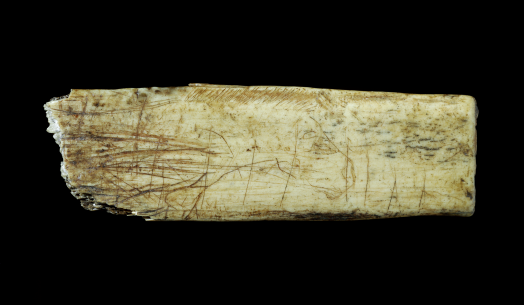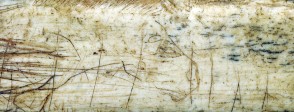
The earliest British art
Anatomically modern humans, Homo sapiens, probably arrived in Europe from Africa via the Middle East around 45,000 years before the present. They seem to have brought the idea of art with them. In Europe we are perhaps most familiar with the beautiful cave paintings and engraved pictures found in caves such as Lascaux and Chauvet in France and Altamira in Spain. Engravings of deer, bison and perhaps birds were found on the walls of one of the caves in Creswell Crags, but it is hard to tell whether these were also painted.
Humans also made smaller engraved and carved objects out of bone and ivory, which are known as portable art. This engraved rib bone from Robin Hood Cave in Creswell Crags is the only piece of Ice Age portable art showing an animal in Britain. It was found in the nineteenth century and is thought to date to about 12,500 years ago, during a warm period in the last Ice Age. We do not know the species of animal the rib bone came from, but we can recognise the horse that is engraved on it.
The engraving clearly shows the head, neck and forequarters of the horse. The eye and nostrils are clearly indicated and the mane is shown by a series of short engraved lines. Lines engraved over the horse later include a series of verticals which may represent fence posts or possibly spears. Deep lines over the flank of the horse may represent an attempt to erase what went before. The rib was deliberately grooved and snapped across at the right hand end.
Were these cavemen?
Ice Age people are often known as cavemen. While caves were used to live in, some for very long periods, most people lived in tents or similar shelters. These occupation sites are not as well preserved, having been open to the elements for thousands of years, so the evidence we have is biased towards well-preserved occupation sites in caves.
What was the carving for?
Creswell Crags was right at the edge of the ice sheet and the most northerly part of Europe for which we have evidence of human presence at this time. Conditions must have been inhospitable in autumn and winter, but it was clearly worthwhile for bands of hunters to operate in the area. The images in the caves, this engraved bone, a range of other artefacts made of bone, as well as other animal remains, indicate that there were reindeer, bison, horses, hares and wild cows to hunt for food. Finds of bones and teeth indicate that there were also lions, lynx and bears.
It is likely that in summer these people travelled north from their more permanent bases to hunt and build up supplies of food. If they travelled in winter it may have been to get special furs for wearing or possibly to trade. At least one of these hunters either made this piece of art in the cave at Creswell Crags or, more likely, brought it with them. It seems to have been handled a lot, giving it a polished appearance. It may have been kept in a pouch or pocket. Perhaps it was used to record something the hunter had seen, or was handled just before the hunt to bring the owner luck.
More information
Robin Hood Cave introduction
More information about Robin Hood Cave specifically. There is a plan of the cave in the Learning Resources section.
http://www.creswell-crags.org.uk/Explore/the-creswell-area/the-creswell-gorge-and-caves/robin-hood-cave.aspx
Creswell-crags resources
Virtually the Ice Age on the Creswell Crags website is an invaluable source of information and images. The Exhibition Objects section allows you to search for objects by theme.
http://www.creswell-crags.org.uk/Explore/virtually-the-ice-age.aspx
A History of the World in 100 Objects
Discussion of an Ice Age carving of two reindeer in A History of the World in 100 Objects – listen to the programme or read the transcript.
http://www.bbc.co.uk/ahistoryoftheworld/objects/DyfP6g6dRN6WdwdnbIVbPw
Animals of the Ice Age
A blog with discussions of a selection of Ice Age animals.
http://twilightbeasts.wordpress.com/index-of-beasts/
Prehistoric art introduction
An introduction to prehistoric art from the Metropolitan Museum in New York with links to articles about famous painted caves.
http://www.metmuseum.org/toah/hd/preh/hd_preh.htm
Cave paintings
A selection of cave paintings in the Chauvet cave in France dating from 35,000-40,000 years ago.
http://bradshawfoundation.com
Figures of women
An interview with Jill Cook of the British Museum about Ice Age figures of women.
http://www.bradshawfoundation.com/sculpture/jill_cook.php
More information
-
Robin Hood Cave introduction
More information about Robin Hood Cave specifically. There is a plan of the cave in the Learning Resources section.
Source: creswell-crags.org.uk
-
Creswell-crags resources
Virtually the Ice Age on the Creswell Crags website is an invaluable source of information and images. The Exhibition Objects section allows you to search for objects by theme.
Source: creswell-crags.org.uk
-
A History of the World in 100 Objects
Discussion of an Ice Age carving of two reindeer in A History of the World in 100 Objects – listen to the programme or read the transcript.
Source: bbc.co.uk
-
Animals of the Ice Age
A blog with discussions of a selection of Ice Age animals.
Source: twilightbeasts.wordpress.com
-
Prehistoric art introduction
An introduction to prehistoric art from the Metropolitan Museum in New York with links to articles about famous painted caves.
Source: metmuseum.org
-
Cave paintings
A selection of cave paintings in the Chauvet cave in France dating from 35,000-40,000 years ago.
Source: bradshawfoundation.com
-
Figures of women
An interview with Jill Cook of the British Museum about Ice Age figures of women.
Source: bradshawfoundation.com


